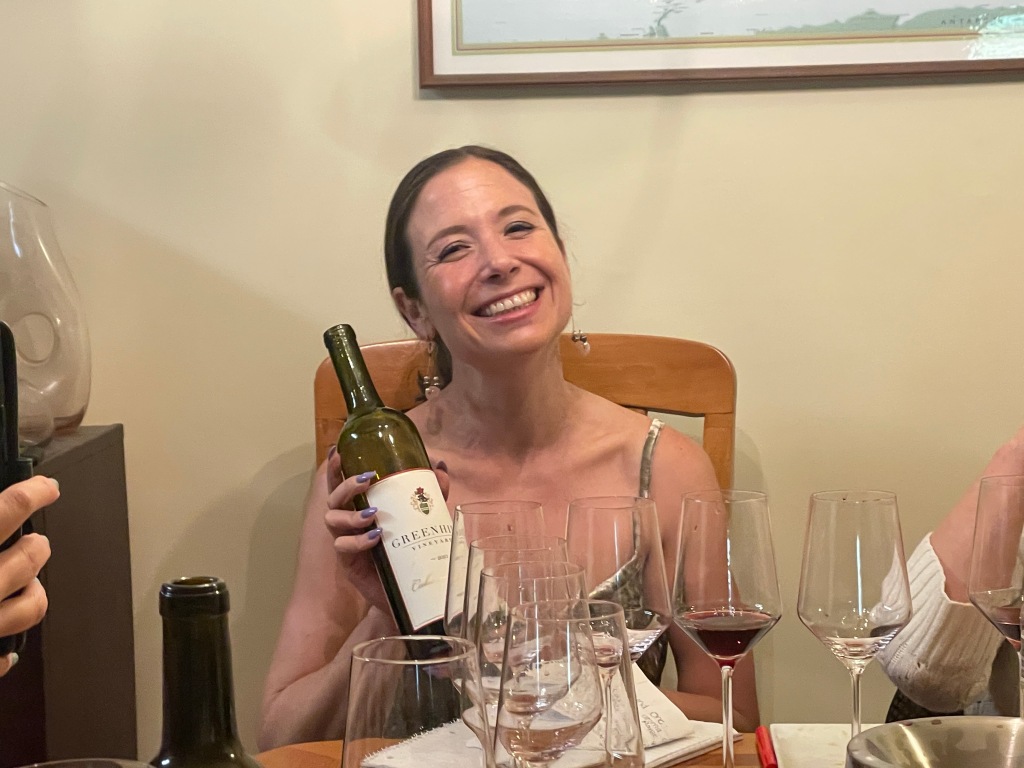You might say that Cabernet Franc is a grape that ‘gets around’.
First off, it’s the most planted wine grape in Virginia. Just over 700 acres of Cabernet Franc is grown in the state – much more than runner-up Chardonnay and leaps and bounds more acreage than #3 Petit Verdot.
Second, Cabernet Franc is one of the parents Cabernet Sauvignon. Back in the 17h century, Cabernet Franc and Sauvignon Blanc got feisty in a French vineyard and produced an offspring which took parts of both parents’ names. So even if you aren’t in love with Cabernet Franc, thank it for being a great parent.
Cabernet Franc possesses a lot of great qualities yet shows them in moderation, including good but not high tannin and acidity, medium body and alcohol, and a floral aroma. This makes it a versatile wine able to be paired with a variety of food options or enjoyed on its own.
It’s also a hardy grape in the vineyard, able to ripen in cooler weather, offers good disease resistance, and doesn’t need a long growing season. Virginia winemakers (and wine growers) constantly sing its praise.
I did a “Virginia Cabernet Francs vs The World” comparison last year with wines from Virginia, France, and the Finger Lakes, but this time around we did a round of 100% Virginia wines. Most were of the 2021 vintage but we had some variation in vintage year.

Tasting & Scoring Methodology
A group of friends & I blind tasted 9 wines in 3 flights. All the flights were bagged blind.
We didn’t have a sophisticated scoring system. The goal was to pick a ‘favorite’ in every flight, as opposed to rating them and determining which one we thought was the ‘best’.
The favorite of every flight went to a ‘finalist’ round. I took the extra step of hiding the ‘finalists’ with a second bag, so any biases of an earlier tasting hopefully didn’t carry over to the final round.
After finishing the final round, we unveiled all the wines and crowned the overall favorite of the day.
This group was composed of friends who are definitely Virginia wine aficionados, so all were very familiar with Cabernet Franc. Only one had industry experience, but the others were more than familiar with blind wine tastings.
The contenders:
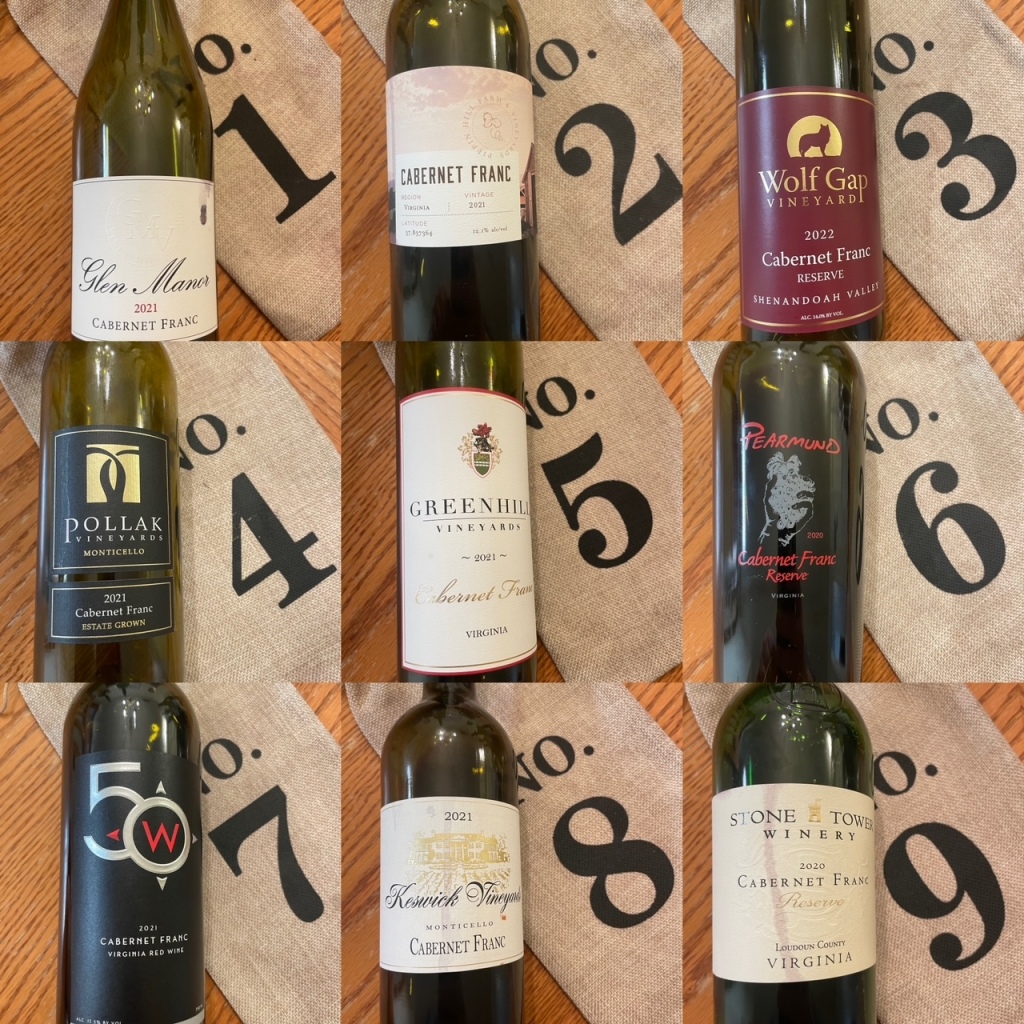
- 2021 Glen Manor
- 2021 Pippin Hill
- 2022 Wolf Gap
- 2021 Pollak
- 2021 Greenhill
- 2020 Pearmund
- 2021 50 West
- 2021 Keswick
- 2020 Stone Tower
Flight #1
- Bottle #1: 2021 Glen Manor (round winner)
- Bottle #2: 2021 Pippin Hill
- Bottle #3: 2022 Wolf Gap
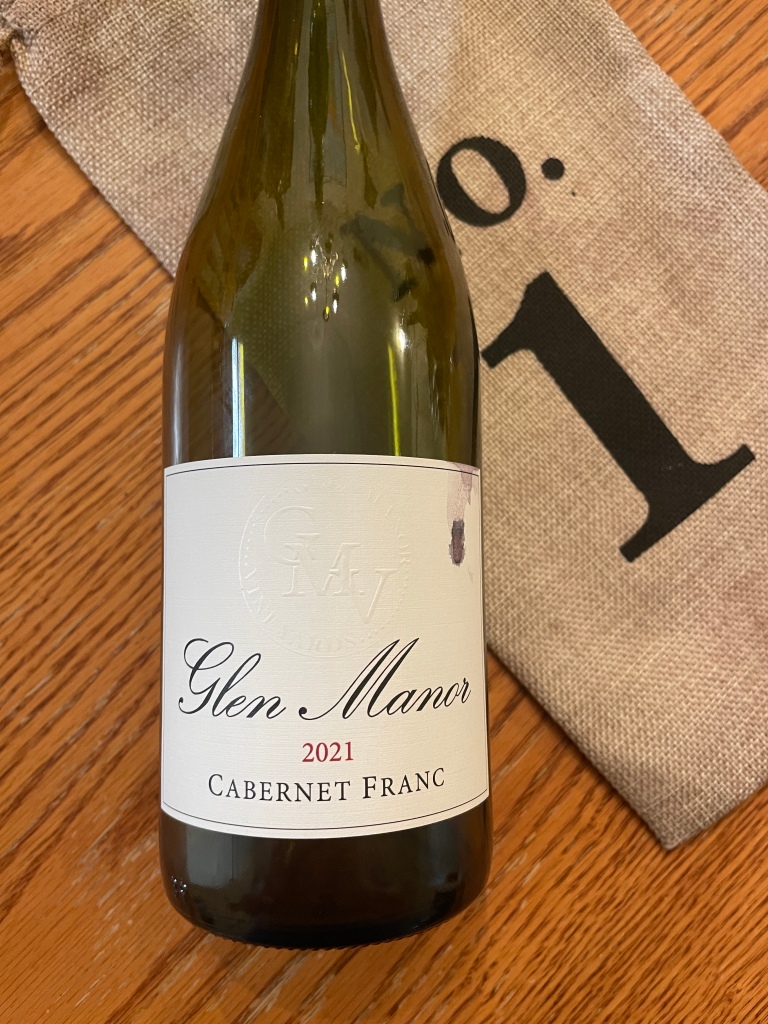

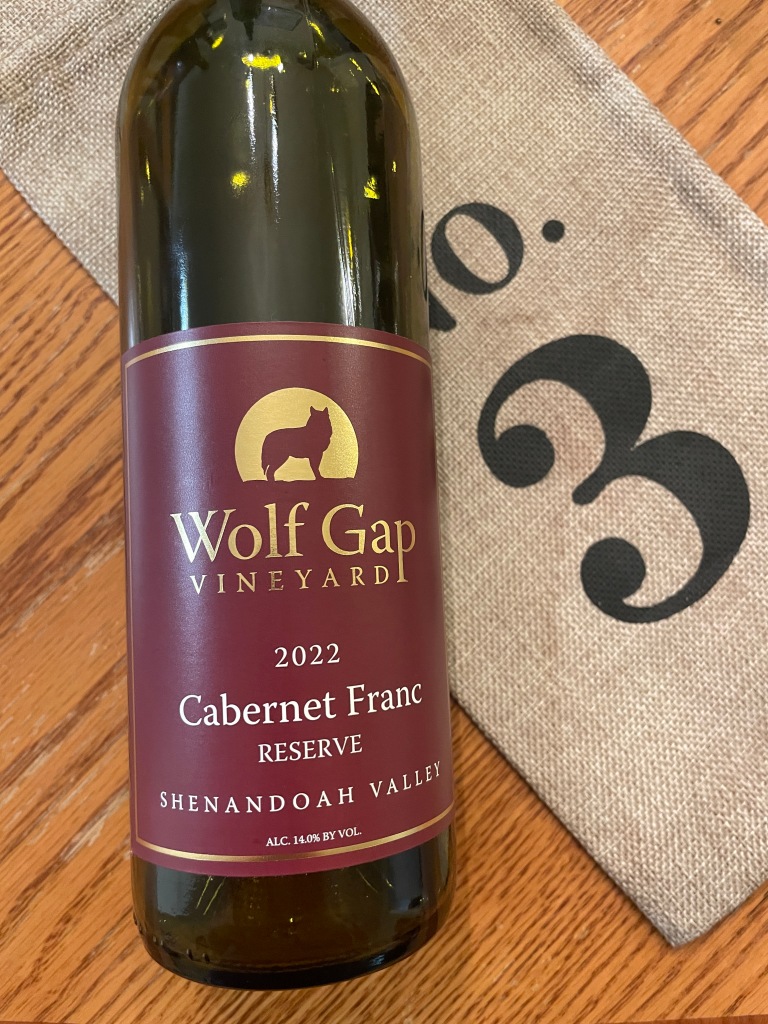
We were immediately struck by how different all of these wines were. #1 leaned into elegance while #2 was fare more traditional. #3 was probably too young for this lineup.
Bottle #1 / 2021 Glen Manor. Earthy nose, but also light and clean. Guests mentioned notes of spice and coco on the palate. It was velvety and tannic; firm tannins were mentioned. Astringent but in a good way.
Bottle #2 / 2021 Pippin Hill. Green pepper on the palate, white pepper on the nose. There initially was a mustiness to it but that went away as the wine opened up. Someone mentioned notes of tart cherry, and the term ‘mocha’ got some traction. Several used descriptors of balanced and smooth. Velvety; maybe a little oaky. One person mentioned too peppery
Bottle #3 / 2022 Wolf Gap. This was our ‘easy drinking wine’. Smooth, but the nose and palate weren’t aligned. Some mentioned notes red pepper and maybe vanilla on the finish. Others mentioned white pepper, or even evergreen and pine on the nose. Soft tannins.
Votes:
- Ann 1/3/2. Liked the astringency and body of #1, but thought #3 was easy drinking
- Ashley 2/1/3. Liked the complexity and spice of #2, but also enjoyed the balance of #1
- Brandon: 1/2/3
- Frank: Tie between #1 and #2, with #3 a more distant third.
- Emily: 2/1/3
- Isabel: 1/2/3. Thought #1 was spicy but bold, with some nice black pepper
- Martha: 2/1/3
- Matt: 1/2/3. I thought #1 was an easy favorite here, for its overall elegance.

Flight #2
- Bottle #4: 2021 Pollak (wild card advance to next round)
- Bottle #5: 2021 Greenhill (round winner)
- Bottle #6: 2020 Pearmund
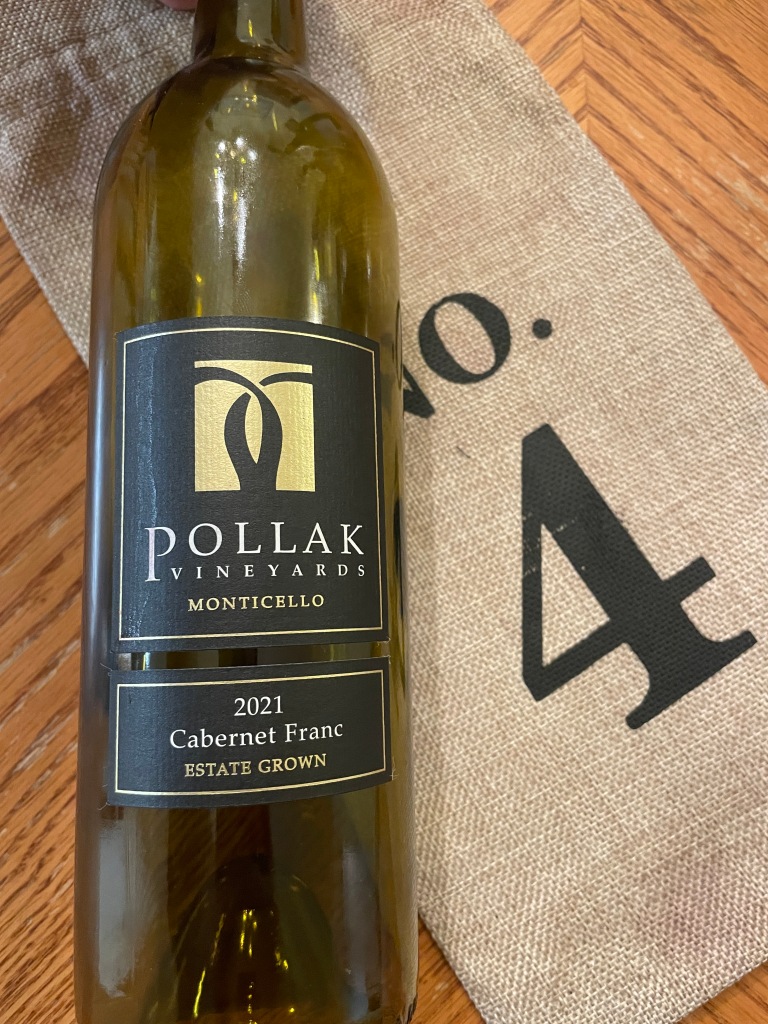

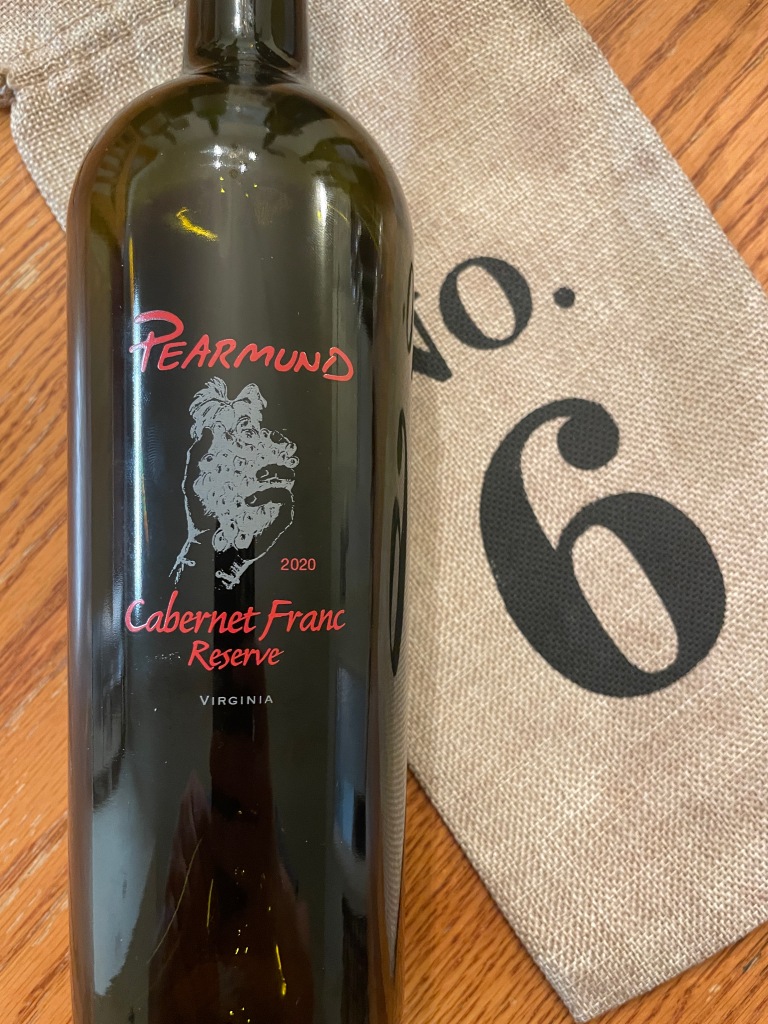
This round was the complete opposite of the previous one. If the 1st round wines were strangers, this round was like seeing triplets, or at least close brothers. This round reminded me more of the Loire than Virginia.
This was also our favorite round of the day (outside of the winners round). While #6 / Pearmund lagged behind in votes, many felt it was easily was the equal to the best of the previous or subsequent flights.
Bottle #4 / 2021 Pollak. Nice complexity; good fruit qualities. Notes such as vanilla, liquorish, or barnyard were bandied out. Others mentioned notes of coco and elderberry on the palate. Acidic and dry.
Bottle #5 / 2021 Greenhill. Complex and rich were the key descriptors. Very light in color but complex on the palate. If Wine #4 (Pollak) was fruit forward, this leaned into the dark fruit. This also had a more ‘traditional’ coco nose as Cab Francs go. Notes of sweet cherry or ripe red cherry were mentioned.
Bottle #6 / 2020 Pearmund. Light color. More vegetal nose, but definitely not in a bad way. Tart cherry was mentioned. Notes of cranberry and dry fruit, plus some tartness.
Votes:
- Ann: 5/4/6. Seemed torn between #4 and #5, as both were complex, lively, and balanced
- Ashley: 5/4/6. Liked the dark fruit of #5
- Brandon: 5/4/6.Thought “#5 had everything”, but especially liked its complexity
- Frank: 5/4/6. Thought #4 was complex and balanced
- Emily: 5/6/4. “Liked everything going on” for #5, but appreciated the fruit on #6
- Isabel: 5/4/6. Focused on the ripe cherry notes of #5; also mentioned its smoothness
- Martha: 5/4/6. Liked the nose on #5
- Matt: 4/5/6
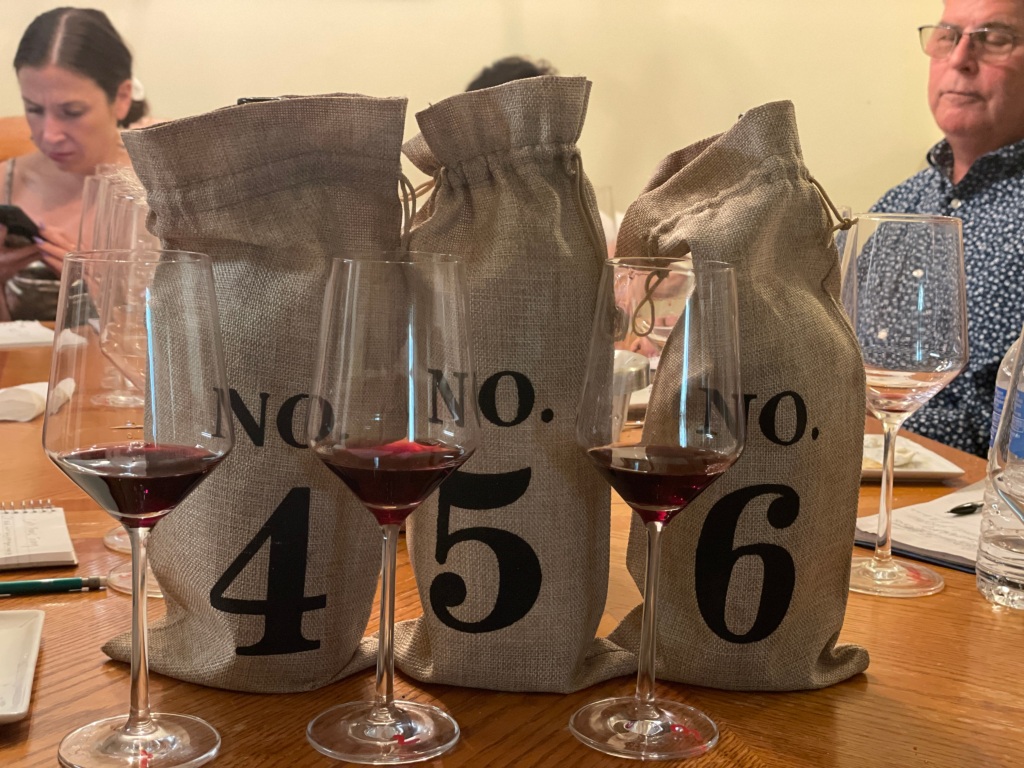
Flight #3
- Bottle #7: 2021 50 West
- Bottle #8: 2021 Keswick (round winner)
- Bottle #9: 2020 Stone Tower
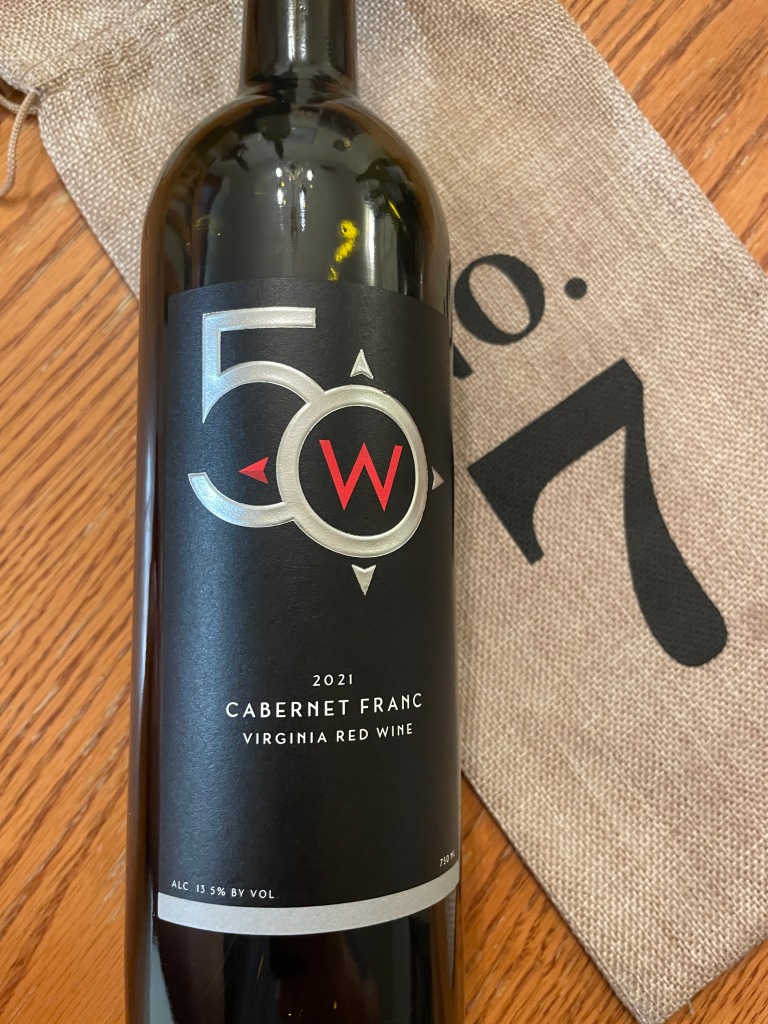
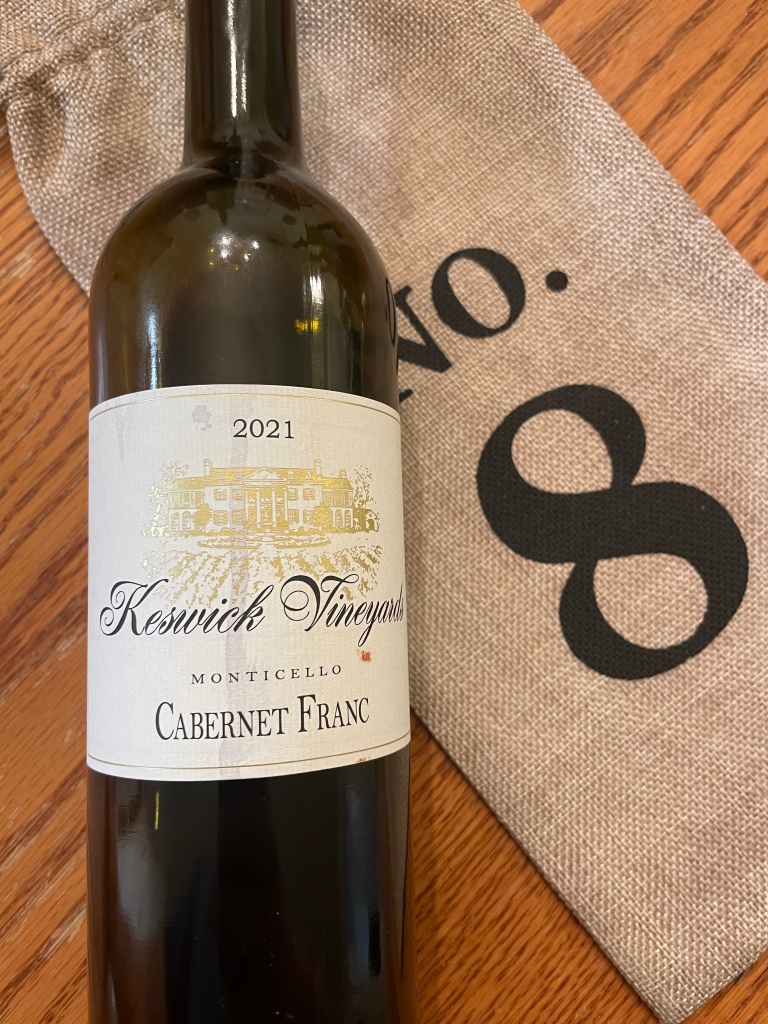

If the previous round were near-triplets, these were brothers. It was also our big & bold group.
Bottle #7 / 2021 50 West. This wine had higher levels of sugar and alcohol than we expected, yet was also on the lighter and peppery side. Sesame nose, notes of tart cherry were mentioned. Mildest nose of the flight. Dark fruit on the palate… maybe plumb? Someone mentioned it was ‘vibrant’.
Bottle #8 / 2021 Keswick. Someone mentioned a ‘beeswax nose’. Regardless, that nose was divisive, with some loving it but others not so much.
But after it opened up, people’s opinions changed. We found it to be fruit forward, with rich raspberry notes. Smooth and lush was also mentioned. Of all the wines we tried, this one needed the most time to reach its full potential. I suspect several people changed their votes once it did.
Bottle #9 / 2020 Stone Tower. Probably the most tannic wine of the entire day. One person mentioned a barnyard-y nose, while another said it had a liquorish, earthy nose. Musky, hints of vanilla. This was a classic, more fruit-forward Virginia Cab Franc. My favorite descriptor is this was a “big stud” of a wine.
Votes:
- Ann: 8/7/9. Thought #8 was bold and has musty nose, but that softened out. Vibrant.
- Ashley: 9/7/8. Though #9 had a liquorish nose
- Brandon: 8/7/9. Thought #8 was barnyard-y but that mellowed out. It was also the earthiest of the bunch (I wonder if he was referring to #9 and I got this wrong?)
- Emily: 9/8/7. Thought #9 had a nice warming sensation; cozy and toasty. Also was fruit forward with a peppery aroma.
- Frank: 8/7/9 complex. #8 had a bell pepper note, and was lush and easy drinking
- Isabel: #8 and #9 were tied, then #7. Felt #8 had earthy and berry notes, while #9 had a tobacco character
- Martha: 8/9/7. Liked the nose and finish of #8, felt it was well balanced
- Matt: 8/7/9. The nose really stood out on #8

Finalist Round

- Bottle #1 / 2021 Greenhill (Bottle #4 in the 2nd flight) Event Winner
- Bottle #2 / 2021 Glen Manor (Bottle #1 in the 1st flight) Runner Up
- Bottle #3 / 2021 Keswick (Bottle #8 in the 3rd flight)
- Bottle #4 / 2021 Pollak (Bottle #5 in the 2nd flight) Third Place
Normally I only pick a single favorite of every flight, but in this case Flight #2 was so universally loved, I picked a ‘wildcard’ to advance to the winning round (turned out to be our 2021 Pollak).
I re-bagged the wines so help prevent any biases from our previous rounds influence this round (although mostly we still guessed which was which). No surprise at who made finalist round; all of these were elegant, complex wines from exceptional producers.
I didn’t take many notes on this time. But after some deliberation we went with the 2021 Greenhill Vineyard Cabernet Franc as the favorite of the day. It was a great example how Cabernet Franc can be light on the palate yet be rich and complex.
I thought the runner-up 2021 Glen Manor Cabernet Franc leaned into that elegance even more, even if it didn’t have the same layer of richness. While GMV was my personal favorite of the day, but I wouldn’t argue with either bottle.
Votes:
- Ann: 2/4/3/1. Went with Glen Manor because of its balance and spice note
- Ashley: 2/1/4/3. Thought the Glen Manor had body but was also clean and complex
- Brandon: 1/4/3/2
- Emily: 1/4/3/2. Loved Greenhill because it was cozy and balanced
- Frank: 1/2/4/3. Thought Greenhill had the lightest style
- Isabel: 1/2/4/3
- Martha: 1/2/4/3. Loved the nose and palate of the Greenhill; soft
- Matt: 2/4/3/1. I gravitated towards Glen Manor because of its richness
Lessons Learned:
First off, all of these wines had ‘Virginia’ written all over them. That’s because Cab Franc is very terroir-influenced, plus it’s so widely grown that different winemakers have different signatures. You can have 9 wines and have 9 very different flavor profiles, yet all of them are recognizably ‘Virginia’ in style.
That said, very broadly this group tended to be divided between more traditional ‘Virginia style’ wines that leaned into the earthiness and pepper notes, and a set of lighter, more refined ‘Loire’ style wines. In this case, the Loire-style wines won the day.
I think the 2020 Stone Tower and 2021 Glen Manor were great examples of this spectrum. The former was a ‘big tannic brute’. The later was more of a ballerina. The 2021 Greenhill and 2021 Pollak were likewise examples of these more refined style. I’ve seen a trend which focuses on the former, but I’m hopeful we’ll keep seeing the later.
One last (late) edit. I also think this event also showcased why certain wineries have the exceptional reputation that they enjoy.
Virginia makes outstanding Cabernet Francs, so it’s hard to go wrong in this category. This particular lineup had a bunch of stars. Even so, going into this event certain names – namely Glen Manor, Keswick, and Pollak – kept being mentioned as likely winners.
It was no surprise that each of those made it into the final round. Despite that, the ‘brown bag’ really helps strip away biases.
Yet it the winner didn’t surprise me at all. Greenhill Vineyards’ Ben Comstock has been making a lot of great wine, racking up a bunch of Double Golds or “Best in Class” at various events. Having the best Cabernet Franc at this event was no surprise at all.
